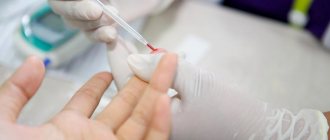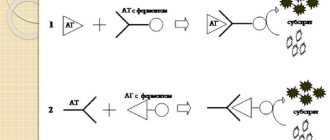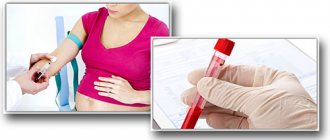Standards of analysis
Only the attending physician can provide full advice on the results of the analysis. However, having the diagnostic result in hand, you can roughly understand the diagnosis before going to his office using the table below.
| How to understand the diagnosis based on the results of tests for hepatitis B? | |||||
| Acute stage of hepatitis B | Chronic form of hepatitis B | Previous hepatitis B | Carriage of hepatitis considered healthy | Indicators available after vaccination | |
| HBsAg | + | “+” for active form of hepatitis B Possible negative result for integrative form | — | + | — |
| HBeAg | “+” for a wild strain “-” for a mutant | “+” for active form of hepatitis B Possible negative result for integrative form | — | — | — |
| Anti-HBs | — | — | + | Both positive and negative results are possible | + |
| Anti-HBe | — | Both positive and negative results are possible | Both positive and negative results are possible | — | — |
| Anti-HBc | + | + | + | + | — |
| Anti-HBc IgM | + | Both positive and negative results are possible | — | — | — |
| HBV-DNA | + | “+” for active form of hepatitis B Possible negative result for integrative form | — | — | — |
Separately, it is worth noting the conditions of latent chronic hepatitis B, resolution of its acute stage, as well as the presence of immunity from a previous disease without a response from the immune system, which have the same test results. The same results can be obtained with a false positive test result.
| How to understand the diagnosis based on the results of tests for hepatitis B? | |||
| · Previous hepatitis B without a response from the immune system | Resolution of the acute stage of hepatitis B | Latent chronic hepatitis B | False positive result |
| HBsAg | — | ||
| HBeAg | — | ||
| Anti-HBs | — | ||
| Anti-HBe | Both “+” and “-” are possible | ||
| Anti-HBC | + | ||
| Anti-HBc IgM | — | ||
| HBV-DNA | — |
Indications for testing
The reason for conducting a clinical trial for antibodies is:
- Contact with an infected person.
- Professional (educational) activities (medicine, education, catering).
- Promiscuous sex life (ignoring contraceptives, frequent changes of partners, non-traditional orientation).
- Undergoing hemodialysis, the procedure of transfusion of blood and its components, donation of internal organs.
- Antisocial lifestyle (addiction to alcohol and drugs).
- Tourists visiting countries in East Asia and Africa.
- Persons serving a prison sentence.
Reference analysis
Any person (man, woman, child) can become infected, so you should not ignore even minor manifestations of the disease. A reference test for hepatitis B is required before vaccination. A test for hepatitis B will detect the disease at an early stage. Timely detection of pathology allows for a high chance of full recovery. In this case, treating the disease is much easier. Immunization against hepatitis B is considered the most effective preventive measure. If the procedure is carried out correctly, the protection will be activated in due time.
Carrying out analysis
There are no special features in preparing for a blood test for hepatitis B. A sufficient condition is considered to be: before the analysis, do not eat for about 10-12 hours.
To diagnose the presence of HBs antigen in the blood, there are two main methods:
- express diagnostics;
- serological diagnosis.
Express diagnostics can be carried out independently (without the help of a doctor) at home; serological testing is exclusively the prerogative of laboratories.
Laboratory research provides a more accurate description of the course of the disease. Laboratory diagnostics require special equipment and reagents.
Express diagnostics
A rapid test outside the laboratory can show whether HBsAg exists in the body. To carry out a quick method, you can purchase special test reagents at the pharmacy and, using capillary blood, perform diagnostics at home. It does not provide numerical and qualitative characteristics of antigens. If the test is positive, the person must be additionally examined in the laboratory.
For such an analysis, it is possible to use a special kit purchased at a pharmacy, which includes all the necessary components for diagnosis.
The sequence of actions for express diagnostics includes the following procedures:
- Spray your finger with alcohol and let it dry.
- Prick your finger with a lancet or scarifier.
- Take 2-3 drops of blood and place it on the test strip.
- Do not touch the strip with your finger so as not to affect the analysis result.
- After 1 minute, lower the strip into the container from the kit, into which 3-4 drops of buffer solution are added.
- The result of the HBsAg analysis can be assessed in 10-15 minutes.
Serological type of diagnosis
Today there are 2 methods of serological testing of HBsAg:
- RIA (radioimmunoassay);
- XRF (fluorescent antibody reaction).
The material to be taken for analysis is human venous blood, or more precisely, its plasma, which is collected as a result of processing in a centrifuge.
Serology has been used for a long time and is characterized by particular specificity and high accuracy. It helps determine the presence of HBsAg within 21 days after the virus enters the body. Serological testing can detect certain anti-HBs antibodies, which, in turn, appear several weeks after the patient has recovered. The number of these formations continuously increases and is preserved for life. A person gradually develops a stable immunity against hepatitis.
The HBs antigen blood test is only the first step to study the development of hepatitis B. A positive result for HBsAg from 0.01 ng per 1 ml to 500 μg per 1 ml indicates the presence of the following types of hepatitis B virus in the patient, such as:
- latent form or carriage;
- incubation period;
- acute form of the disease;
- chronic form of the disease.
Viral hepatitis is a category of infectious diseases that affect liver cells. The most common among all types of hepatitis is hepatitis B. Despite all attempts by doctors to strengthen preventive measures against this disease, statistics show that the number of people who have taken an HBsAg blood test and received a positive result remains quite large.
Decoding the results
Determination of surface HBs antigen most often occurs by enzyme immunoassay. The obtained indicators are deciphered as follows:
- Less than 10 mIU/ml – there is no normal immune response to the hepatitis B vaccine. A negative result found during other specific tests indicates the absence of infectious contamination.
- 10–100 mIU/ml means complete recovery after the acute period of hepatitis B, carriage, chronic phase of the pathology.
Testing for antibodies and antigens of hepatitis B, carried out before vaccination, is done in order to:
- weed out virus carriers;
- evaluate the effectiveness of immunization after a certain period of time;
- determine the need for re-vaccination. This usually happens after 5–7 years.
Viral symptoms are a cause for concern. These include pain in the hypochondrium, jaundice, changes in the color of urine and feces. Women registering for pregnancy must have their blood tested.
The liver is a parenchymal organ that does not have nerve endings. Therefore, pathological changes in its functional tissues remain unnoticed for a long time. The diagnosis is made based on information recorded during a complete examination.
Liver
A positive result is a reason to prescribe additional studies. HBSAg blood tests are not always reliable. Indicators are deciphered taking into account all related factors. False indicators may be obtained if:
- Less than 21 days passed between infection and the start of the examination.
- The antigen subtype did not match the type of enzyme immunoassay kit.
- The patient is infected with hepatitis C and (or) HIV infection.
- A person is a carrier of the virus.
Hepatitis B is a serious disease that rarely becomes chronic. The immune response to the hepatitis B virus occurs several months after the disappearance of the HbsAg antigen. This period of time is referred to as the serological window. The appearance of antibodies in place of antigens is called seroconversion. This is an indication that the patient is beginning to recover.
The virus that provokes the development of hepatitis B forms a set of serological markers. Specific studies prescribed to the patient allow for dynamic monitoring. Based on the information obtained in this way, the doctor can predict the further development of the pathology and select effective treatment. As a last resort, he prescribes surgery for a patient suffering from hepatitis B.
Decoding the results
Only a qualified specialist can correctly evaluate the result of the analysis, since there are a lot of subtleties that need to be read when decoding.
Several final options are possible:
- negative;
- positive;
- false negative;
- false positive.
Negative
Can we say that if the Australian antigen is not detected in the patient’s blood, the person is healthy? In this case, experts talk about several scenarios:
- The immune system defeated the virus.
- There is no hepatitis B virus in humans.
- The infection develops in a chronic form, in which the virus multiplies so weakly that it is not possible to detect it using modern tests.
Quite often, a negative analysis may indicate the following processes:
- Liver failure develops - the virus destroys liver cells so quickly that it does not have time to multiply.
- The patient has hepatitis B and hepatitis D at the same time, and this changes the configuration of HBsAg and the surface antigen is not detected.
- I have hepatitis B, the virus has not been identified because it has mutated.
Positive
If antibodies to the surface antigen of the virus are detected in the patient’s blood, it can be assumed that the patient has an acute form of hepatitis B.
However, in other situations there may be a positive result:
- hepatitis is present in a chronic form;
- the patient is healthy and is only a carrier of the virus;
- a history of illness;
- availability of vaccination against hepatitis B virus;
- decreased immunity during long-term illnesses, including the presence of AIDS.
In some cases, a false positive result is recorded, then the patient is prescribed a repeat test and additional studies.
Incorrect readings may occur due to the following factors:
- violation of the research process of the obtained material;
- use of low-quality reagents;
- outdated equipment in the clinic.
A false positive result can also be caused by:
- improper preparation for blood donation;
- the patient donated blood in the presence of an infectious process that occurs with a high temperature;
- the presence of benign or malignant tumors;
- taking potent drugs;
- the presence of autoimmune processes;
- pregnancy.
According to statistics, every third person on Earth is a carrier of hepatitis B or is infected with it. In many countries there are State programs that are aimed at early detection of markers of hepatitis B. It is the HBsAg antigen that is the earliest signal of human infection.
A blood test for HBsAg is available in almost all medical institutions, and you can also purchase an express kit at a pharmacy to carry out the test yourself. However, it is better to donate blood in a laboratory.
If it is not possible to stand in line at public clinics, there is always the opportunity to conduct this test in a private clinic. The cost of an HBsAg test, depending on the region and clinic, ranges from 200 to 600 rubles.
HBsAg
Hepatitis B surface antigen (HBsAg) is a protein that is present on the surface of the virus that causes hepatitis B. It is found in the blood of acute and chronic hepatitis B.
Synonyms Russian
Hepatitis B virus surface antigen.
English synonyms
Hepatitis B surface antigen.
Research method
Chemiluminescent immunoassay.
What biomaterial can be used for research?
Venous blood.
How to properly prepare for research?
- Do not smoke for 30 minutes before the test.
General information about the study
Hepatitis B is an infectious liver disease caused by the HBV virus.
The HBV virus is a common cause of hepatitis B. The true number of people infected is believed to be higher than official statistics, as many people infected experience only mild symptoms and are unaware that they have the virus. Around the world, about 350 million people are infected with hepatitis and about 620 thousand die from it every year.
The HBV virus spreads through contact with the blood or other body fluids of an infected person. You can become infected, for example, through using the same syringe needle or through unprotected sexual contact. Traveling to places where hepatitis B is common is also dangerous. A mother can infect her baby during or after childbirth. The virus, however, is not transmitted through food and water, or through everyday contact such as shaking hands, coughing or sneezing.
Tests for bilirubin and liver function detect hepatitis, but do not reveal its cause. It is the test for HBsAg in the blood that determines hepatitis B and the HBV virus that causes it.
The hepatitis B virus is DNA surrounded by a protein capsule - capisdom, which is responsible for the process of introducing the virus into the body's cells. The capsid proteins are called HBsAg (from the English “hepatitis B surface antigen”), HBcAg (“hepatitis B core antigen”) and HBeAg (“hepatitis B capsular antigen”). Their presence in the blood suggests that a person is infected with the virus, so testing for the presence of these antigens is a standard method for diagnosing hepatitis B.
HBsAg is the surface antigen of the hepatitis B virus. When the virus enters a cell, it begins to produce new DNA chains, multiply, and the HBsAg antigen is released into the blood. In acute hepatitis B, it appears in the blood 3-5 weeks after infection (in the last 1-2 weeks of the incubation period) and usually persists until the end of the first 2-3 weeks of clinical manifestations. In chronic hepatitis B, HBsAg is detected at all phases of the disease. Detection of HBsAg during a screening examination is an indication for consultation with an infectious disease specialist and further examination for other markers of the hepatitis B virus in order to verify the diagnosis and clarify the stage of the disease.
What is the research used for?
- To screen for infection in the absence of symptoms of disease.
- To find out whether the disease is acute or chronic.
- For the control of chronic hepatitis B.
- To test for hepatitis B in risk groups or blood donors.
- To identify previous infections (in case of subsequent acquisition of immunity).
- To find out whether immunity has developed after vaccination.
When is the study scheduled?
- When the patient has symptoms of acute hepatitis: fever, fatigue, loss of appetite, nausea, vomiting, abdominal pain, dark urine, light-colored stool, joint pain, jaundiced skin.
- When screening patients at high risk for hepatitis B infection. These include: healthcare workers who may become infected through accidental cuts, punctures, etc.
- people born in regions where HBsAg prevalence is over 2% (most countries in Asia and Africa),
- those who have not been vaccinated against hepatitis in a timely manner (in Russia - in the first 12 hours and a month after birth),
- those whose parents come from regions where the prevalence of HBsAg exceeds 8%,
- men who practice same-sex sex,
- patients whose liver enzyme levels (ALT and AST) are elevated for unknown reasons,
- patients with diseases requiring suppression of their immune system,
- pregnant women,
- who are in close contact with people infected with HBV,
- AIDS patients.
What do the results mean?
Reference values (HBsAg norm): negative.
The test for HBsAg in the blood can be prescribed either alone or in combination with other tests for hepatitis B. Their results are usually assessed together. Sometimes the interpretation of an HBsAg test depends on the results of related tests for hepatitis B.
HBsAg - positive result:
- early acute infection
- late stage of acute infection, accompanied by seroconversion,
- active chronic infection (usually associated with liver damage),
- chronic infection with low risk of liver damage (virus carrier stage).
HBsAg - negative result:
- no active infection
- passing infection (recovery stage), immunity due to spontaneous infection,
- immunity due to vaccination.
Important Notes
- Even if there are no symptoms of hepatitis B, the HBV virus can damage the liver and be passed on to others. Therefore, if there is a suspicion of infection, timely testing, including the HBsAg test, is very important.
- The HBsAg antigen is not detected in the blood during the recovery period.
Also recommended
- Viral hepatitis A. Examination of contact persons
- Viral hepatitis A. Monitoring effectiveness after treatment
- Viral hepatitis C. Tests for primary detection of the disease. Examination of contact persons
- Viral hepatitis C. Tests before starting treatment
- Viral hepatitis C. Monitoring viral activity during and after treatment
- Laboratory examination of the liver
- Liver function
- Aspartate aminotransferase (AST)
- Alanine aminotransferase (ALT)
- Gamma-glutamyl transpeptidase (gamma-GT)
Who orders the study?
Infectious disease specialist, therapist, gastroenterologist, hepatologist, pediatrician.
What to do
We have looked at the main reasons, and now we know what it means if HBsAg is negative. But at present, none of the doctors will rely on the diagnosis of viral hepatitis B, or any other hepatitis, only by conducting just one of numerous tests.
Yes, indeed, the study of the Australian antigen is the best suited for examining numerous population groups, or for conducting screening. It is very convenient: it appears in the blood first and disappears later than all. The analysis is done quickly and is not expensive. Thus, it is possible to identify carriers or patients from a risk group, or enroll them there in case of a positive result. But we saw that even with a negative test value, in some cases the presence of infection cannot be ruled out.
Therefore, if a person has any complaints from the liver, or signs of chronic intoxication, as well as if he himself is aware of the possible risk of infection, then this patient needs to undergo a full range of virological examinations for hepatitis B.
Indications, for example, would be intravenous drug addiction, multiple sexual partners and unprotected sex, or frequent visits to beauty salons, medical procedures involving blood transfusions and much more. First of all, a PCR test will be required, then a determination of the remaining markers or antigens of the virus, and, finally, a determination of antibodies.
Finally, the development of the hepatitis virus in the body can be determined indirectly, by a biochemical blood test, by detecting a decrease in liver function, by the presence of symptoms of cytolysis and necrosis of liver tissue, as well as by other nonspecific signs.
In conclusion, it should be said that an examination by an experienced infectious disease doctor and a full story from the patient about his complaints and the history of the development of the disease can provide a lot of information so that the diagnosis is made as early as possible. This contributes to timely initiation of treatment and speedy recovery.
What is HBs–Ag?
Before we talk about what a blood test for the presence of HBsAg indicates, we need to talk about what it is and the importance of its role in diagnosing the disease.
The hepatitis B virus, like any virus, consists of envelope protein compounds and hereditary material, or nucleocapsid (viral core). The surface shell of the virus contains the same Australian antigen, which is called HBsAg. Since after infection with a virus, the first and most superficial structure of the pathogen that the human body encounters is this antigen, it is called the main, or first marker of this disease.
This antigen appears very first, even in the incubation period of the disease, before the appearance of the first clinical signs. It is known that even before the appearance of jaundice and symptoms of hepatitis, nonspecific liver damage can be diagnosed using a biochemical blood test, which will detect high liver enzymes - ALT, AST, GGTP and other compounds responsible for cytolysis, or destruction of hepatocytes.
But cytolysis is a process that can occur not only due to viral liver damage, but also with toxic hepatitis. Therefore, the detection of an antigen in the patient’s blood can, under certain conditions, be considered the first signs of the disease that can only be identified. Only PCR is diagnostic, and the detection of hereditary viral material can compete with HBsAg in diagnostic efficiency.
In case of infection with viral hepatitis, this compound can be detected in the patient’s blood within a week. This occurs because a hepatocyte infected with a virus synthesizes viral particles unevenly: and the synthesis of viral proteins very often prevails over the number of copies of the hereditary material. This misgrading leads to the patient being HBsAg positive.
Further, in the acute phase of the disease, the HBs antigen remains in the patient’s peripheral blood for about six months and then disappears from it. Moreover, it disappears last, after other antigens. Thus, this protein marker appears first and disappears last, remaining in the blood the longest.
But the disease is not limited to the acute process. If this marker remains in the blood six months after infection or longer, this indicates that the patient now has hepatitis B in a chronic form. The patient can also carry this antigen for life.
If the result is positive, the picture is more or less clear. In any case, the patient has the hepatitis virus. Therefore, we can talk about either acute hepatitis, or a chronic disease, or carrier state. It should be remembered that if HBsAg is positive, this only means the presence of infection in any form.
In order to clarify, other research methods are needed - PCR diagnostics, quantitative determination of hereditary material, study of other antigens, study of antibodies to HBs-Ag and to other nuclear antigens of the virus. And when is a negative answer possible and this marker is not detected? Is it then possible to say unequivocally that the patient is healthy and does not need to undergo any other tests?
Polymerase chain reaction as a method for diagnosing hepatitis
Polymerase chain reaction is one of the most accurate methods for diagnosing the viral infection in question. However, this method has a number of disadvantages. Firstly, it is quite expensive and is not on the list of offered tests in many medical laboratories. Secondly, there is a small chance of obtaining a false positive result. Therefore, to finally confirm the diagnosis, it is recommended to repeat the test in another laboratory after a certain time.
This research method consists of directly identifying viral particles that are present in the bloodstream. Therefore, this study is direct, as opposed to indirect methods for diagnosing hepatitis B with markers. It is worth noting that it is better to perform such an analysis as prescribed by a doctor who specializes in infectious diseases.
Diagnosis of hepatitis B - methods
Currently, laboratory PCR systems of varying degrees of sensitivity are available on the medical market. This means that at extremely low concentrations of the virus in the blood, for example, during remission of the disease, a false negative result is possible. Therefore, the polymerase chain reaction method cannot be used separately from other methods for diagnosing this dangerous viral liver disease. Only on the basis of a set of information obtained as a result of examination, questioning of the patient, and the use of various laboratory and instrumental research methods can a diagnosis be made or refuted.
Can there be a false positive result?
Absolutely any test can give false positive results, and an antigen test is no exception. Since this diagnostic method is one of the most accurate, in case of an erroneous result, either low-quality reagents or insufficiently competent laboratory workers can be blamed. In any case, before looking for the answer to the question “Australian antigen is positive - what does this mean?”, it is necessary to undergo an additional examination that will confirm or refute the corresponding diagnosis.
What is a blood test for HBsAG
Blood test for HBsAG is a fairly common type of blood test for viral hepatitis B. It is the most accessible, popular and cheapest type of test. It is precisely because of its accessibility that this analysis has become a screening test, that is, used during mass examinations, during planned hospitalization, and when prescribed to designated groups of the population.
Perhaps the HBsAG test is generally the most well-known test performed using modern technologies for any infectious disease.
Previously, this analysis was done by the gel precipitation reaction method, then by the immunoelectrophoresis method, or by the fluorescent antibody method (2nd generation). And currently there are 3rd generation test systems: RIA, or radioimmunoassay, and enzyme-linked immunosorbent assay (ELISA).
The fact is that if all standards of sterilization and processing could be guaranteed to destroy the hepatitis B virus, then there would be no need to think about other pathogens at all. They would all be destroyed. The fact is that this particular virus is a real record holder in the fight against all disinfectants and in resistance to environmental factors. It is not destroyed by freezing, repeated, boiling, or the action of a weak acid (Remember, strong, inorganic acids will dissolve any tissue, but they are not found in nature).
The virus, for example, is capable of infecting a person after lying in a freezer for 15 years at a temperature of -15 degrees. It is guaranteed to be destroyed, for example, by dry heat sterilization for an hour at a temperature of 160 degrees and similar “barbaric methods”
And one of these virus structures that successfully resists all environmental factors is HBsAG, or Australian antigen. Let us examine in detail what kind of object of laboratory analysis this is, and what role this indicator plays if it is positive or negative.
Results
Hepatitis is a severe liver pathology that threatens the development of cancer and death. Complete relief from the disease is recorded only in 10% of cases. A blood test for HBsAg is the most informative way to detect the disease. Timely diagnosis makes it possible to begin the fight against the virus at the initial stage of its introduction.
The earlier treatment is started, the greater the patient’s chances of increasing life expectancy, on average by 10–15 years. Immunity to the virus is guaranteed only by vaccination. Vaccination is carried out in three stages: primary, repeated (after a month), consolidating (after six months). For children, the injection is given intramuscularly, for adults - in the forearm area.
What is HBsAG
A single HBsAG antigen is a special protein molecule, or lipoprotein. In fact, there are many of these molecules, and they all dot the outer surface of the virion, or “one particle” of the virus. The task of this antigen is the adhesion of viruses to the surface of the liver cell - the hepatocyte, or adsorption. Adsorption is the first stage of viral aggression; without adsorption, penetration of the virus into the cell is impossible. Therefore, we can consider this antigen as a kind of special forces, which are the first to land on the “enemy shore and strengthen their position.”
Only after this task is completed can the virus integrate into the human genetic material and force the liver cells to produce their own viral proteins and nucleic acids. After this, the blood test for Australian antigen becomes positive. It is called Australian because it was first discovered in the blood of an Australian aborigine by the famous virologist Samuel Blumberg, and this happened in 1964.
This is the first hepatitis B virus antigen known to mankind. Any cause leads to an effect: the appearance in the blood of viral particles dotted with surface antigens leads to the production of antibodies that have the same name (these antibodies to HBsAG are called anti HBsAG). In general, any antigen has its own pair - an antibody. And all these viral agents and their corresponding antibodies gradually appear in the peripheral blood, which can be detected in test results.
Laboratory research
Serodiagnosis allows you to identify specific markers at different stages of the infectious process. The first sign of human infection is a surface antigen, which can be detected in the incubation period (4-6 weeks after infection), in the preicteric stage and during the acute phase.
Location of hepatitis B virus antigens
Of the existing serological methods for studying viral antigens and antibodies, ELISA is the most informative because it:
- highly sensitive;
- is available in the form of instrumental (qualitative and quantitative) and visual accounting;
- is automated at all stages of the reaction, which eliminates the error of the laboratory assistant.
Definition
Hepatitis B is the most common type of hepatitis.
The course of the disease is not pronounced, for this reason it is extremely difficult to recognize it for research. Many people suffering from this type of hepatitis are unaware of their problem for a long time. There are three ways to become infected with the virus. This is unprotected sexual contact, blood and from mother to child during childbirth.
There are some indications for conducting an Hbs study:
- the patient has already suffered hepatitis of unknown etiology;
- for the control and treatment of the chronic form of viral hepatitis type B;
- the need to examine a person exposed to the risk of infection with this virus;
- the need to determine the feasibility of using hepatitis B vaccine.
If the test result is positive, recovery from an illness can be diagnosed or the effect of taking a vaccine can be proven. If the result is negative, the doctor can talk about the absence of hepatitis, as well as post-vaccination immunity to the virus.
A negative result can be detected at the initial stage of disease development, that is, at the incubation stage. The Hbs test is a test to identify antigens to the virus. Its indicator is an early marker of a person’s certain predisposition to a given disease.
The hepatitis B virus has a complex structure. Its shell consists of small protein molecules. They contribute to the appearance of antibodies to the virus in human blood. It is in their presence or absence that a person is diagnosed as sick or healthy.
If antibodies of this type are present in a person’s blood for six months, this indicates that the disease has become chronic. Carrying out an HBS analysis allows you to timely identify the disease, as well as assess the need for vaccination.
Different types of diagnostics can be used to carry out the analysis:
- express;
- serological.
When is HBsAg hepatitis tested?
Today, the detection and diagnosis of viral hepatitis in the early stages is of great importance. Therefore, in addition to those who are quite attentive to their health and take this test for preventive purposes, there are categories of citizens who are obliged to do this. These include:
- pregnant women twice – when registering them at the antenatal clinic and immediately before giving birth;
- medical workers - mainly those who, due to their professional activities, work with blood and other physiological fluids (surgeons, gynecologists, laboratory assistants, nurses);
- patients - before any planned surgery;
- people with liver diseases (cirrhosis) and biliary tract;
- drug addicts;
- blood donors before donating blood;
- persons who have unprotected sex and frequently change partners;
- patients with all forms of hepatitis.
Who needs to get tested regularly?
Anyone who does not have the appropriate vaccination can get this disease. This is why such people need to be tested frequently for this disease. According to doctors, for this it is enough to carry out a diagnosis once every few years, and without any reason. There is a certain category of people who definitely need this analysis:
- Medical staff.
- Women bearing children.
- Donors.
- Family members with the patient.
- Children whose mothers are carriers of the infection.
- People with symptoms of liver and biliary tract disease.
- Hospitalized patients.
- Before surgery.
- People who use drugs.
- People planning to be vaccinated against this disease.
- People with chronic illnesses that require frequent contact with medical instruments designed to work with blood.
This list needs to be continued with people who returned from prison, the army, or who had unprotected sex.
What markers are used to determine hepatitis B?
The HBsAg marker is the first, the main indicator of viral hepatitis B, but not the only one of its kind
In addition to it, other antigens are also taken into account when making a diagnosis.
Read more about them in the table below.
| Markers confirming the presence of hepatitis B | ||
| Marker | How is the definition read? | What does it matter? |
| HBsAb | Protective antibodies that react to HBV surface antigen | The HBsAb blood test is used to detect previous illness, antibodies introduced by a vaccine, or to confirm hyperimmune hepatitis after the first weeks of infection. |
| HBeAb or anti-HBe | Antibodies to antigen "e" | The “e” antigen, found in almost all patients, indicates the beginning of complete recovery. |
| HBcAb IgM | M-antibodies to nuclear type antigen | Antibodies are detected in the blood from 60 days after the infection occurred. A positive test for HBcAb IgM indicates an acute stage or infection. It is also an indicator of active destructive processes in the liver. |
| HBcAg | Nuclear antigen | It is not detected in the blood, but is detected during examination of a liver biopsy taken. |
| HBV-DNA | Hepatitis B virus DNA samples | A positive test means the presence of hepatitis B virus in the blood and confirmation of the disease. |
| HBcAb | Antibodies detected a week or two after HBsAg testing | Used when there is doubt about the veracity of HBsAg, in combination with HBcAg. |
Confirmed hepatitis B requires additional diagnosis of delta hepatitis.
Hepatitis D virus (or delta infection) is the virus that causes hepatitis D disease. For its development, a previous infection with the hepatitis B virus is necessary. To be sure of the health status regarding superinfection, the markers described in the following table are used.
| Markers confirming the presence of hepatitis D | ||
| Marker name | How is the definition read? | What does it matter? |
| HDAg | Special antigen of delta infection. | A positive test result indicates the presence of hepatitis D. |
| HDV-RNA | Determining the presence of virus RNA in the blood | The marker indicates the presence of delta infection in the human body. |
| IgM anti-HDV | Antibodies to delta infection, belonging to class M | Determines the division marking of the disease virus. |
| IgG anti-HDV | Antibodies to hepatitis D virus, belonging to class G | Indicates a history of hepatitis D or its current presence. |
How to prepare for the analysis, and what are the indications for taking it?
It is known that many tests require special preparation. This especially applies to biochemical tests, which are very “picky”. Do I need to prepare for the Australian antigen test?
But no special preparation is required for this study. The only rule that must be followed is coming to the laboratory on an empty stomach. The HBsAG test is sensitive to various substances that enter the bloodstream after eating and various false-positive results are possible because immune bodies may react incorrectly. Therefore, a blood test should be carried out no earlier than 4 hours after the last meal. Of course, the best time is early morning.
There is one more circumstance that needs to be taken into account by patients with viral hepatitis: if the doctor assumes that the patient has become infected with viral hepatitis B, then he should be sent for a blood test one and a half months from the moment of possible infection. If this is done earlier, then the liver cells simply will not have time to produce viral particles and release them into the blood.
But by what symptoms can a doctor understand that a patient needs to take a blood test for this antigen? What indications exist in order to suspect its presence? Here are the main clinical situations in which assignment to this study is justified:
- Increased levels of transaminases, that is, ALT and AST;
- suspicion of long-term intravenous drug addiction in the patient;
- symptoms of viral hepatitis, acute or chronic, for example, jaundice, arthralgia;
- chronic liver diseases;
- frequent sexual intercourse and changing sexual partners (this may indicate the presence of a virus);
- in the presence of a focus of infection and for examination in groups (outbreaks);
- examination of health workers, donors, newborns from mothers who are healthy carriers of the virus;
- in order to prepare for vaccination for hepatitis B;
- in preparation for pregnancy and for testing pregnant women;
- routine examination in patients with frequent intravenous injections and manipulations (for example, those attending plasmapheresis sessions who are on chronic hemodialysis).
Finally, an hbs antigen test is required to prepare for hospitalization and planned surgery.
Preparation and carrying out the procedure in laboratory conditions
No complicated preparation is required for the HBsAg test, but some rules must still be followed:
- Two weeks before the test, you must stop taking potent medications; this issue should be discussed in detail with your doctor.
- For three days you need to give up alcohol, fatty and spicy foods.
- The day before donating blood, you need to moderate physical and psychological activity, it is advisable to stop smoking.
- Blood is donated in the morning on an empty stomach, the last meal should be the day before during dinner.
- You can drink clean water without restrictions, including the time immediately before donating blood.
Laboratory diagnostics
In serology, the HBsAg blood test has long been used. The method is distinguished by its originality and reliability. HBsAg is detected in the third week after infection. The Australian antigen leaves the blood in humans 90 days after entry. In exceptional cases, lifelong virus carriage is noted. An infected patient may remain clinically healthy.
Serum diagnostics can detect antibodies to the Australian virus. They are formed by the time of recovery, a month after the antigen is removed.
Anti-HBs bodies appear in a recovered person 4 weeks after the antigen disappears. The concentration of antibodies constantly increases, providing lifelong immunity against the causative agent of hepatitis B. Post-vaccination immunity is formed according to a similar pattern.
Determining the antibody titer after vaccination is a diagnostic technique that checks the effectiveness of vaccination. The material for laboratory analysis is 10 ml of blood taken from the elbow vein. Blood is donated on an empty stomach early in the morning. Analysis results are received within 24 hours.
Patient preparation
Before blood is drawn, a person must undergo certain measures. There is no special preparation, but in order to exclude a false-positive result, it is advisable to stop taking medications 14 days before blood sampling. If this action is not possible, the issue is discussed with the doctor individually.
Experts recommend adhering to the following rules:
- exclude alcoholic drinks;
- do not smoke before donating blood;
- carry out analysis on an empty stomach;
- limit physical activity before the procedure;
- eliminate stress loads.
To determine the antigen, venous blood is required in an amount of 5–10 ml. After submitting the biological material, it takes two days to complete a full-fledged study.











